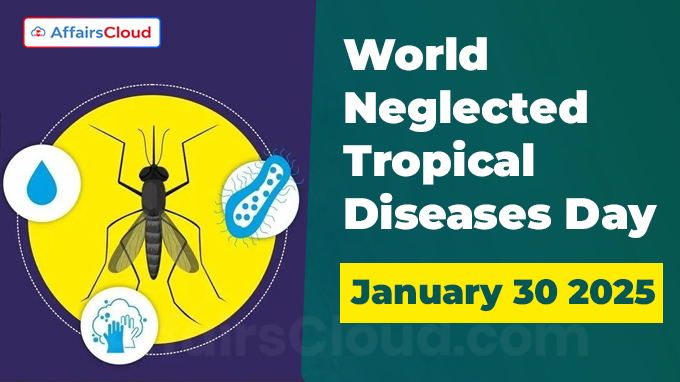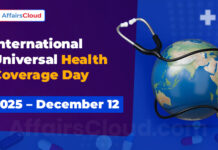 The World Health Organization’s (WHO) World Neglected Tropical Diseases Day (WNTDD) is observed annually on January 30 across the globe to raise awareness of the devastating impact of NTDs on the most vulnerable populations around the world.
The World Health Organization’s (WHO) World Neglected Tropical Diseases Day (WNTDD) is observed annually on January 30 across the globe to raise awareness of the devastating impact of NTDs on the most vulnerable populations around the world.
Theme:
i.The theme of WNTDD 2025:“Unite. Act. Eliminate” emphasizes the collective commitment needed to end these diseases.
ii.The theme urges leaders and communities to unite and make bold, sustainable investments to eliminate NTDs and free an estimated 1.5 billion people in the most vulnerable communities from the cycle of disease and poverty.
Background:
i.WNTDD was 1st announced by the Crown Prince Court of Abu Dhabi, United Arab Emirates (UAE) at the 2019 Reaching the Last Mile Forum held in Abu Dhabi.
- The inaugural observance was observed on January 30 2020.
ii.On May 31,2021, the 74th World Health Assembly (WHA) designated January 30 as WNTDD through decision WHA74(18), a proposal supported by the UAE, Oman, Brazil, and other member states.
iii.This day is now recognized as one of the 11 Global Health Days and 2 Global Health Weeks by the WHO.
Note: As of December 2024, 54 countries had successfully eliminated at least one NTD worldwide.
Why January 30 ?
i.On 30th January 2012, WNTDD marked the release of the 1st NTD Roadmap (2012-2020) alongside the adoption of the London Declaration on NTDs, which highlighted the global impact of neglected tropical diseases.
ii.The WHO launched the new NTD road map (2021-2030) on January 28, 2021.
iii.The WHO’s NTD roadmap (2021–2030) and the Kigali Declaration 2022 on NTD set ambitious targets for control and elimination.
- The primary goal of WHO is to eliminate at least one NTD in 100 countries by 2030.
About Neglected Tropical Diseases (NTDs):
i.NTDs are a group of treatable and preventable conditions caused by parasites, bacteria, viruses, and fungi, impacting over 1 billion people worldwide.
ii.These diseases comprise around 20 conditions and are most common in tropical and subtropical areas, where poor living conditions, limited access to sanitation, clean water, and healthcare exacerbate their spread.
iii.Affecting the world’s most impoverished populations, NTDs contribute to 1000 of preventable deaths each year
Global Challenges:
i.NTDs affect millions globally, with burdens in the WHO Eastern Mediterranean and South-East Asia regions.
ii.Interventions for NTDs benefit from one of the largest global medicine donation programs, with 12 manufacturers providing donations of 20 different medicines to support NTD efforts.
- An estimated 75 million people require interventions against NTDs in the Eastern Mediterranean Region.
iii.In South-East Asia, 16 NTDs remain endemic, with 833 million people still needing interventions, in each of the 11 Member States.
iv.Between 2010 and 2022, the number of people requiring interventions against NTDs in the Region decreased by 54%.
v.Between 2011 and 2024, nearly 30 billion tablets and vials were delivered to countries, with 1.8 billion tablets and vials donated and delivered for treatments in 2024 alone.
vi.In 2024, 7 countries achieved the elimination of an NTD and in 2023, over 860 million people received treatment for NTDs through mass drug administration and individual disease management efforts.
- 10 countries in the Region had eliminated at least one NTD by 2024.
NTDs Elimination Strategies:
The Regional Strategic Framework for the elimination of NTDs in the South-East Asia Region (2024–2030) outlines a clear and comprehensive roadmap to tackle these diseases through 3 strategic pillars. It includes:
i.Strengthening Country ownership, Leadership and Stewardship,
ii.Accelerating Programmatic Actions, and
iii.Intensifying Integrated and Cross-Cutting Approaches.
About World Health Organization (WHO):
Director-General (DG)-Tedros Adhanom Ghebreyesus
Headquarters- Geneva, Switzerland
Established- April 7, 1948




